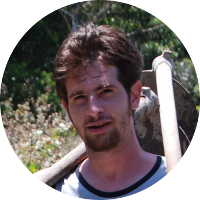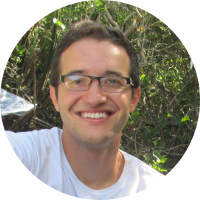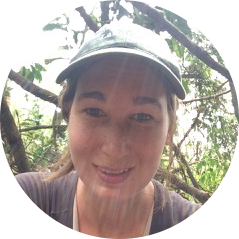
 Diane Srivastava
Diane Srivastava
My research is motivated by curiosity about the natural world, interests in conservation and a passion for ideas. I grew up exploring the forests and lakes of Nova Scotia, and my ecological fieldwork has since taken me around the world, with research in Central and South America, Africa, England and arctic and temperate Canada. Many of my research ideas are developed through mentoring students and postdoctoral fellows. If you are interested in joining my research group, please click here.
 Sarah Amundrud (PhD Student)
Sarah Amundrud (PhD Student)
Research on ecological effects of climate change has traditionally focused on direct, physiological effects on species; however, we are beginning to recognize its potential to alter ecological communities and ecosystem processes indirectly, by affecting species interactions. Foundation and keystone species exert particularly strong effect on communities, and thus present a high potential to mediate ecological effects of climate change. In Monteverde, Costa Rica, water-filled bromeliads provide habitats (i.e. are foundation species) for diverse invertebrate food webs and occur along a climate (elevation) gradient. The keystone predator (damselfly-larvae) is absent from bromeliads in the relatively cool and wet high elevation bromeliads. Thus, these miniature ecosystems are ideal systems to examine the relative importance of direct and indirect ecological effects of climate change. I am combining observational, experimental, and modeling techniques to tease apart which factors best explain community composition: climate; habitat; or predators. Moreover, I use modeling techniques to predict community and ecosystem changes under future climate scenarios.
 Gustavo Cauê (PhD Student, UNICAMP)
Gustavo Cauê (PhD Student, UNICAMP)
Gustavo is co-advised by Gustavo Romero and Diane Srivastava
Interested in the effects of cross-ecosystem trophic cascades, particularly the magnitude effects of predators living in land-water boundaries on aquatic ecosystem functioning.
 Melissa Guzman (PhD Student)
Melissa Guzman (PhD Student)
Dispersal is an important mechanism in structuring community composition at regional scales. It can increase population ranges, prevent local extinction and increase the genetic pool for adaptation. The aquatic invertebrate community in bromeliads create food webs where they disperse from one bromeliad to the next forming metacommunities. I am interested in understanding the role of dispersal in food webs and how it structures a community at different scales. For this I'm going to do a series of experiments and models. I will estimate dispersal distances using a NGS approach.
 Ana Z. Gonçalvez (PhD Student, UNICAMP)
Ana Z. Gonçalvez (PhD Student, UNICAMP)
Ana is co-advised by Gustavo Romero and Diane Srivastava
Different predator ants can construct their nests in tank bromeliads and they can alter the composition and species diversity in these micro-ecosystems through the predation behavior. Depending on the behavior of the ants, they can have different effects on the species composition in the bromeliads and alter the food chains, causing trophic cascades between the terrestrial and aquatic ecosystems. Furthermore, they can also alter ecosystem processes (e.g., nutrient cycling and its availability to plants). In this context, I am interested in the influence of different predator ants on the nutrition and development of their host bromeliads and how they alter the terrestrial and aquatic biota in these plants.
 Nicholás Marino (PhD Student, UFRJ)
Nicholás Marino (PhD Student, UFRJ)
Nicholas is co-advised by Vinicius Farjalla and Diane Srivastava
Climate change is an ongoing process that is already affecting several parts of the Earth. Ecological and evolutionary studies on the impacts of climate change traditionally focus on ecosystem and community-wide impacts of changes in temperature. However, changes in the precipitation regime are also predicted to occur - increasing the sensitivity of aquatic habitats to climate change. Moreover, some key direct (i.e. density mediated) and indirect (i.e. trait-mediated) species interactions, such as predation, may be disrupted or lost, amplifying the impact of climate change. Using tank-bromeliads as a model-system, I am interested in understanding how changes in precipitation can affect the consumptive and behavioural roles of predation in aquatic ecosystems.
 Pierre Rogy (MSc Student)
Pierre Rogy (MSc Student)
The citrus greening disease is a bacterial field disease affecting citrus trees and spread by the jumping plant louse Diaphorina citri. It greatly reduces the lifespan of trees and makes the fruit unusable, causing substantial economic impacts. Biological control can be an efficient disease management strategy, and is already implemented in various orange orchards. If bromeliads are present in orchards, bromeliad-associated predators, such as ants, scorpions and spiders, and the biological control agents would compete for the same lice. However, the impacts of predation efficiency of several predators targeting the same prey item is highly context-specific and poorly understood. Thus, I am interested in assessing whether those predators can be used as a supplement to biological control in a synergistic relationship, which could have important consequences in terms of ecosystem services and pest management.
 Natalie Westwood (PhD Student)
Natalie Westwood (PhD Student)
Forest fragmentation is a common problem that affects many landscapes, especially in the neotropics. This can lead to changes in how food webs are constructed, and consequently may change ecosystem processes in these communities. I am interested in understand how top-down and bottom-up controls on a community may affect the community composition and the ability for that community to function. I will also work to understand how these controls may differ in the context of forest fragmentation. In order to test this I will manipulate aquatic treehole communities in both fragmented and intact forest to determine the effects of both types of controls.
Former lab members
Jonathan Lui built a database for the lab to allow
collaboration among members of the
Bromeliad Working Group.
Andrew MacDonald completed a PhD concerning the ecological and evolutionary
causes and consequences of species diversity along environmental gradients.
Alathea Letaw completed a PhD on
the factors influencing community composition in bromeliads in Brazil.
Angie Nicolás
completed an MSc studying the impact of forest fragmentation on
insect communities from tree holes in Costa Rica.
Aliny Patrícia Flauzino Pires
completed her PhD, co-advised by
Vinicius Farjalla. She
used tank-bromeliads to test how detritus diversity interacts with
changes in precipitation to affect ecosystem functioning and community structure
in the restinga of Jurubatiba National Park, Brazil.
Kurt Trzcinski completed a postdoc, co-advised by
Régis Cereghino. His research focused on how energy flow through bromeliad
aquatic ecosystems affects community dynamics and ecosystem function.
Angélica González
completed a postdoc, applying ecological stoichiometry to bromeliad insect communities.
Paula Omena completed her PhD, co-advised
by Gustavo Romero.
She studied habitat-mediated predation using bromeliad spiders as a study system.
Fernanda Azevedo completed her PhD, co-advised by
Vinicius Farjalla.
Robin LeCraw
defended her PhD studying functional diversity and biogeography of bromeliad insect communities.
Ali Naqvi was a research assistant who helped create a photo key of bromeliad insects.
Michael Millar was a research assistant who helped expand our mite and bromeliad insect identification
webpages by contributing photographs and drawings, and identifying countless specimens.
Cora Skaien
was an honour's student in the lab studying the impacts of tadpoles on bromeliads and their invertebrate communities.
Virginia Noble completed her MSc on the consequences of tropical
forest fragmentation and land conversion on leaf litter decomposition and nutrient recycling in Guanacaste, Costa Rica.
Youhua Chen
defended his MSc on the impact of disturbance on mite
diversity as well as phylogenetic diersity-related issues, like how ecological processes structure
phylogenic clustering or evenness patterns.
Edd Hammill
completed a postdoc in the lab. His
research concerns how inducible defences in prey affect dispersal and population dynamics in meta-communities.
Gennifer Meldrum
defended her MSc in investigating how dispersal rate between habitat
patches interacts with synchronicity of disturbance across the landscape to influence biodiversity and
community resilience in a moss-microarthropod ecosystem.
Andrea Stephens
completed her PhD, studying the biological control
of the invasive weed, diffuse knapweed by insect herbivores.
Melissa Cuke completed an MSc in the lab.
Pavel Kratina completed a postdoc in the lab.
Jana Petermann
completed a postdoc in the lab.
Martin Videla completed a postdoc in the lab.
Silvina Fenoglio completed a postdoc in the lab.
Jiichiro Yoshimoto
was a visiting scholar in the lab studying the moss-mite ecosystem.
Jessica Beaubier completed an MSc in the lab.
Jackie Ngai completed a PhD in the lab.
Brian Starzomski
completed a PhD in the lab.
Ben Gilbert
completed a PhD on native and non-native plant distributions.
Katsky Venter
Xiang Zhu


